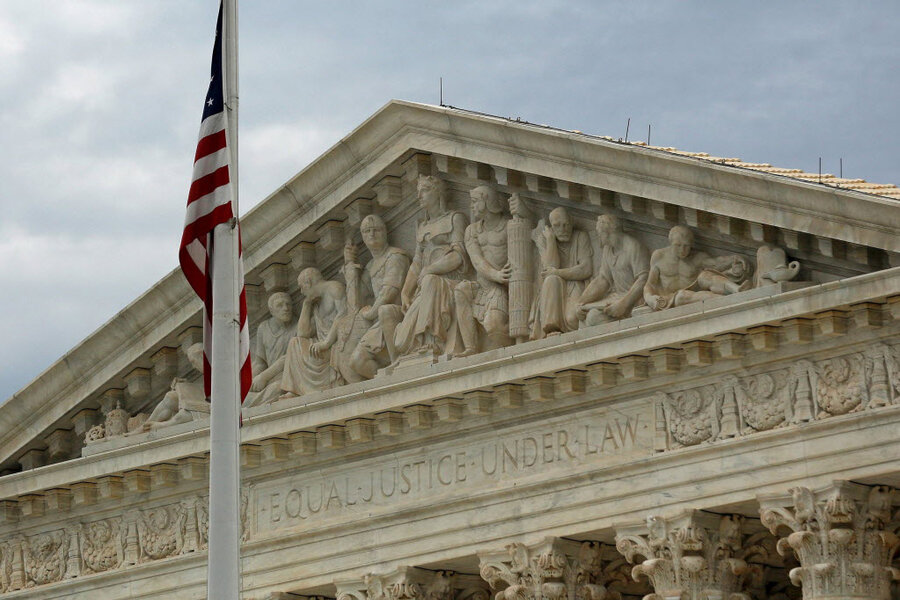Why Supreme Court effectively upheld a local assault weapon ban
Loading...
The US Supreme Court handed gun control advocates a modest victory on Monday, deciding not to hear a challenge from gun rights activists to a Chicago suburb’s ordinance banning assault weapons.
The ordinance from the city of Highland Park, Ill., passed in 2013, bans various semi-automatic weapons (it also bans some weapons by name, including AR-15s and AK-47s) as well as magazines holding more than 10 rounds of bullets.
The Illinois State Rifle Association and Dr. Arie S. Friedman, a Highland Park resident, challenged the ordinance in the Chicago-based United States Court of Appeals for the Seventh Circuit. A divided three-judge panel for the appeals court upheld the ordinance in an April ruling. The plaintiffs asked the Supreme Court to review the appeals court decision, but the high court declined.
The justices gave no reason for turning down the appeal, as is their custom, and the ruling continues a trend that has seen the Court refuse to hear a Second Amendment since 2010.
The Second Amendment to the US Constitution protects an individual’s right to keep and bear arms, but legal arguments over its scope have persisted for decades.
In 2008 case District of Columbia vs. Heller the Court ruled for the first time that the Second Amendment guaranteed an individual right to bear arms, although the ruling only applied to firearms kept in the home for self-defense. In 2010, the court extended that principle to the states.
Four members of the nine-person court need to vote to take up a case. Only Justices Clarence Thomas and Antonin Scalia, two conservatives on the court, said the justices should have taken the case.
Justice Thomas wrote in a six-page dissent that several lower courts "have upheld categorical bans on firearms that millions of Americans commonly own for lawful purposes."
The Supreme Court should have heard the appeal of the Seventh Circuit’s ruling, he added, to prevent the appeals court ruling "from relegating the Second Amendment to a second-class right."
The Highland Park ordinance specifically bans only "unusual and dangerous firearms." Questioning whether semi-automatic rifles fit that definition, Thomas argued in his dissent that semi-automatic rifles are popular, and that the majority of owners use them for lawful purposes.
"Under our precedents, that is all that is needed for citizens to have a right under the Second Amendment to keep such weapons," he added.
Lawyers for Highland Park, in defense of the ordinance, noted that it was enacted "following a series of tragic mass shootings across the nation," including the 2012 shooting at Sandy Hook Elementary School in Connecticut, where a gunman killed 20 first graders and six adults. Armed with a semi-automatic rifle, the gunman was able to fire 154 rounds in less than five minutes.
The states of New York and Connecticut passed assault weapons bans in the wake of that shooting.
"The Second Amendment is not unlimited," said Stephen Elrod, an attorney for Highland Park, according to the Associated Press. "The Supreme Court recognizes that there are certain categories of guns that do not fall within the protections of the Second Amendment."
Outside the constitutionality of local assault weapons bans, some question whether such bans are even effective at reducing gun violence. Citing FBI statistics, The Christian Science Monitor's Harry Bruinius previously reported that only 248 of the nearly 12,000 murders committed in the United States in 2014 were perpetrated with rifles of any sort. Handguns, meanwhile, were used in nearly half of murders in the US in 2014.
A 2004 study led by the University of Pennsylvania criminologist Christopher Koper examining the federal assault weapons ban – which was implemented in 1994 but allowed to expire by a bitterly-divided Congress ten years later – concluded that the bans success was "mixed."
Mr. Bruinius writes: "Crimes involving assault weapons did decline, but this decline was offset, the report concluded, by an increase in the use of other guns equipped with high-capacity magazines. It also concluded, however, that it was 'premature to make definitive assessments of the ban’s impact on gun crime,' and its overall effects were 'still unfolding' when the law expired."
Yet the split Seventh Circuit decision, which the Supreme Court has chosen to not review, illustrates the tension in the issue that, for the moment, favors those who support gun control.
"A ban on assault weapons and large-capacity magazines might not prevent shootings in Highland Park (where they are already rare), but it may reduce the carnage if a mass shooting occurs," wrote Judge Frank H. Easterbrook in the Seventh Circuit’s majority opinion.
He added: "If a ban on semiautomatic guns and large-capacity magazines reduces the perceived risk from a mass shooting, and makes the public feel safer as a result, that’s a substantial benefit."
Material from Reuters was used in this report.








